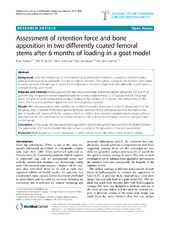| dc.contributor.author | Harboe, Knut | en_US |
| dc.contributor.author | Gjerdet, Nils Roar | en_US |
| dc.contributor.author | Sudmann, Einar | en_US |
| dc.contributor.author | Indrekvam, Kari | en_US |
| dc.contributor.author | Søreide, Kjetil | en_US |
| dc.date.accessioned | 2014-09-02T09:24:41Z | |
| dc.date.available | 2014-09-02T09:24:41Z | |
| dc.date.issued | 2014-08-16 | eng |
| dc.identifier.issn | 1749-799X | |
| dc.identifier.uri | https://hdl.handle.net/1956/8396 | |
| dc.description.abstract | Background: Since the introduction of uncemented hip implants, there has been a search for the best surface coating to enhance bone apposition in order to improve retention. The surface coating of the different stems varies between products. The aim was to assess the retention force and bone adaption in two differently coated stems in a weight-bearing goat model. Materials and methods: Hydroxyapatite (HA) and electrochemically deposited calcium phosphate (CP; Bonit®) on geometrically comparable titanium-based femoral stems were implanted into 12 (CP group) and 35 (HA group) goats. The animal model included physiological loading of the implants for 6 months. The pull-out force of the stems was measured, and bone apposition was microscopically evaluated. Results: After exclusion criteria were applied, the number of available goats was 4 in the CP group and 11 in the HA group. The CP-coated stems had significantly lower retention forces compared with the HA-coated ones after 6 months (CP median 47 N, HA median 1,696 N, p = 0.003). Bone sections revealed a lower degree of bone apposition in the CP-coated stems, with more connective tissue in the bone/implant interface compared with the HA group. Conclusion: In this study, HA had better bone apposition and needed greater pull-out force in loaded implants. The application of CP on the loaded titanium surface to enhance the apposition of bone is questioned. | en_US |
| dc.language.iso | eng | eng |
| dc.publisher | BioMed Central | eng |
| dc.relation.ispartof | <a href="http://hdl.handle.net/1956/10366" target="blank">Developing a novel femoral stem in hip arthroplasty. An innovation process using a weight-bearing animal model</a> | |
| dc.rights | Attribution CC BY | eng |
| dc.rights.uri | http://creativecommons.org/licenses/by/4.0 | eng |
| dc.subject | Hydroxyapatite | eng |
| dc.subject | Calcium phosphate | eng |
| dc.subject | Loaded animal model | eng |
| dc.subject | Hip replacement | eng |
| dc.subject | Implant stability | eng |
| dc.title | Assessment of retention force and bone apposition in two differently coated femoral stems after 6 months of loading in a goat model | en_US |
| dc.type | Peer reviewed | |
| dc.type | Journal article | |
| dc.date.updated | 2014-08-27T15:05:21Z | |
| dc.description.version | publishedVersion | en_US |
| dc.rights.holder | Knut Harboe et al.; licensee BioMed Central Ltd. | |
| dc.rights.holder | Copyright 2014 Harboe et al.; licensee BioMed Central Ltd. | |
| dc.source.articlenumber | 69 | |
| dc.identifier.doi | https://doi.org/10.1186/s13018-014-0069-4 | |
| dc.identifier.cristin | 1175366 | |
| dc.source.journal | Journal of Orthopaedic Surgery and Research | |
| dc.source.40 | 9 | |

